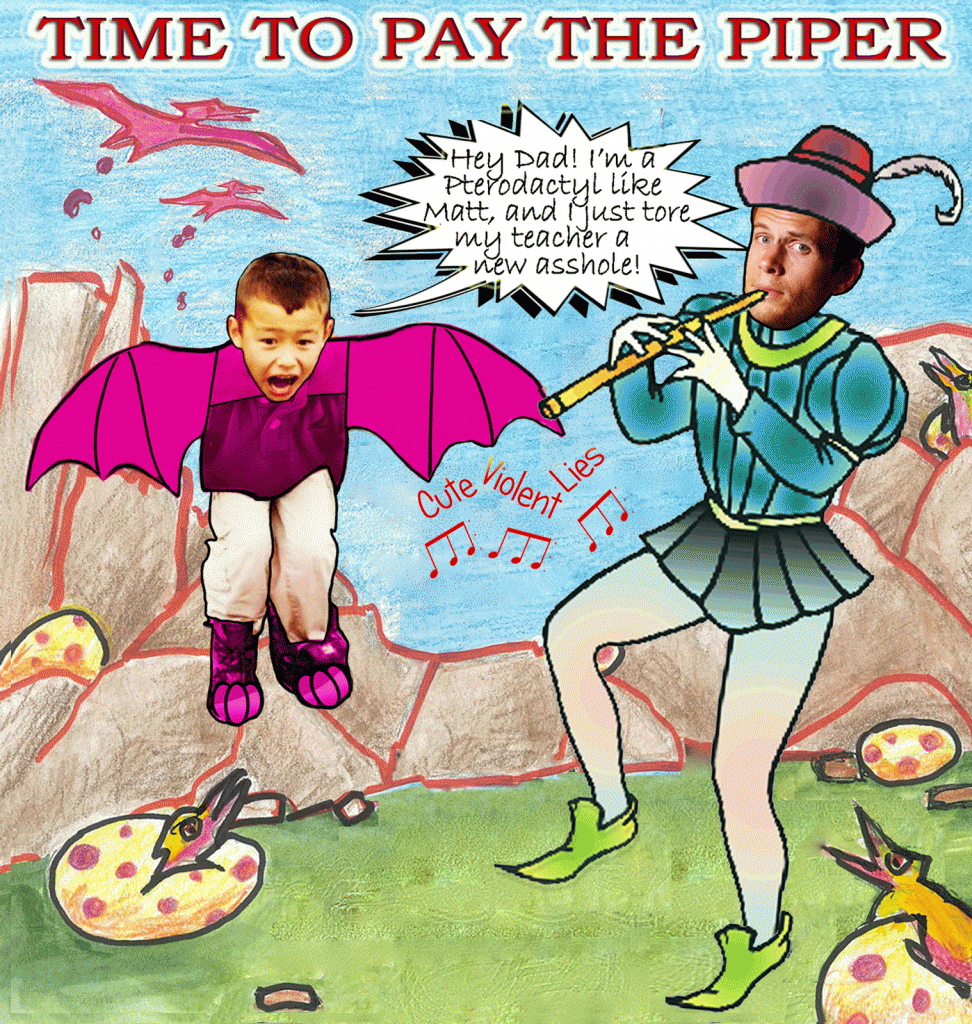Having Matt Inman as a role model might be problematic for Christopher and Diana Recouvreur in their efforts to properly raise little Gabe. Just like you wouldn’t want your kid to get infected by exposure to porn, you need to be careful that he doesn’t absorb this Oatmeal stuff. He could easily, like his dad, grow up to think it was cool to tear people new assholes, and then what would you say to him if he came home and said this?

Time to Pay the Piper, by Tara Carreon
(Matt Inman dressed as the Pied Piper seducing Gabe Recouvreur into being a pterodactyl obsessed with tearing people new assholes.)
Rapeutation.com
The third short-term process, imitation of specific aggressive behaviors, can be viewed as a special case of the more general long-term process of observational learning (Bandura, 1986; Huesmann, 1998). In recent years the evidence has accumulated that human and primate young have an innate tendency to imitate whomever they observe (Butterworth, 1999; Meltzoff & Moore, 2000; Rizzolati, Fadiga, Gallese, & Fogassi, 1996; Wyrwicka, 1996). These theories propose that very young children are likely to imitate almost any specific behaviors they see. Observation of specific aggressive behaviors around them increases the likelihood of children behaving exactly that way (Bandura, 1977; Bandura, Ross, & Ross, 1963). Granted, not all aggression is learned; in children two to four years old, proactive-instrumental behaviors that might be called aggressive (e.g., pushing another child without any provocation to get a desired object) appear spontaneously (Tremblay, 2000), as may hostile temper-tantrums. However, the observation of specific aggressive behaviors at that age leads to the acquisition of more coordinated aggressive scripts for social problem-solving and counteracts environmental forces aimed at conditioning the child out of aggression. As the child grows older, the social scripts acquired though observation of family, peers, community, and mass media become more complex, abstracted, and automatic in their invocation (Huesmann, 1988, 1998). Additionally, children’s social-cognitive schema about the world around them begin to be elaborated. In particular, extensive observation of violence around them biases children’s world schemas toward attributing hostility to others’ actions (Dodge, 1985; Gerbner, Gross, Morgan, & Signorielli, 1994). Such attributions in turn increase the likelihood of children behaving aggressively (Dodge, 1980; Dodge, Pettit, Bates, & Valente, 1995). As children mature further, normative beliefs about what social behaviors are appropriate become crystallized, and begin to act as filters to limit inappropriate social behaviors (Huesmann & Guerra, 1997). Children’s own behaviors influence the normative beliefs that develop, but so do the children’s observations of the behaviors of those around them including those observed in the mass media (Guerra, Huesmann, Tolan, Van Acker, & Eron, 1995; Huesmann, Guerra, Zelli, & Miller, 1992; Huesmann, 2003). In summary, social-cognitive observational-learning theory postulates long-term effects of exposure to violence through the influence of exposure on the development of aggressive problem-solving scripts, hostile attributional biases, and normative beliefs approving of aggression.
Long-term effects are due to (1) observational learning of social scripts for behavior, of schemas about the world (e.g., is it hostile or benign), and of normative beliefs about the appropriateness of aggressive behavior; (2) emotional desensitization to violence; and (3) justification processes based on social comparisons (Bushman & Huesmann, 2000; Huesmann, 1988, 1998). There is some overlap with short-term effects; long-term effects are also quite likely increased by the habituation process called “desensitization.” Most humans seem to have an innate negative emotional response to observing blood, gore, and violence. Increased heart rates, perspiration, and self-reports of discomfort often accompany such exposure (Cline, Croft, & Courrier, 1973; Moise-Titus, 1999). However, with repeated exposure to violence, this negative emotional response habituates, and the observer becomes “desensitized.” One can then think about and plan proactive aggressive acts without experiencing negative affect. Consequently, proactive aggression becomes more likely.
One other long-term process is probably important. Social comparison theory suggests that humans evaluate themselves by comparing themselves to others. The aggressive child is generally (with some exceptions) not accepted because others do not like to be around aggressive peers (Anderson & Huesmann, in press). Huesmann (1988, 1995, 1998) has suggested that, to counter this threat to self-worth, aggressive children seek out aggressive media. Observing others behaving aggressively makes the aggressive children feel happier and more justified. Viewing media violence makes them feel happier because it convinces them that they are not alone in being aggressive. Of course, the ultimate consequence of such a turn toward more exposure to violent media, is more observational learning of aggressive scripts, schemas, and beliefs, and more desensitization to violence.
— The Case Against the Case Against Media Violence, by L. Rowell Huesmann and Laramie O. Taylor
Nothing Was Delivered, by The Byrds
(Lyrics by Bob Dylan)
Nothing was delivered
And I tell this truth to you
Not out of spite or anger
But simply ’cause it’s true
Now you must provide some answers
For what you sell was not received
And the sooner you come up with it
Then the sooner you can leave
Nothing is better
Nothing is best
Take care of your health and get plenty of rest
Nothing was delivered
And it’s up to you to say
Just what you had in mind
When you made everybody pay
Now I hope you won’t object to this
Giving back all that you owe
But the sooner you come up with it
Then the sooner you can go
Nothing is better
Nothing is best
Take care of your health and get plenty of rest
No, nothing was delivered
I can’t say I sympathise
With what your fate is going to be
Yes, for telling all those lies
No, nothing was delivered
Yes, and someone must explain
But as long as it takes to do this
Then that’s how long that you remain
Nothing is better
Nothing is best
Take care of your health and get plenty of rest